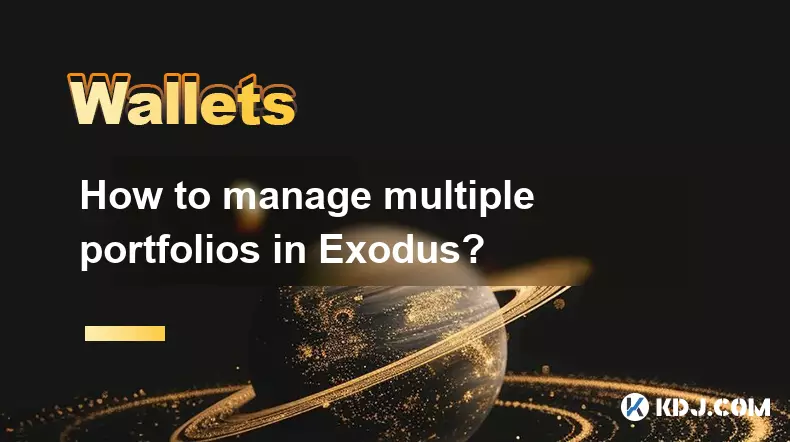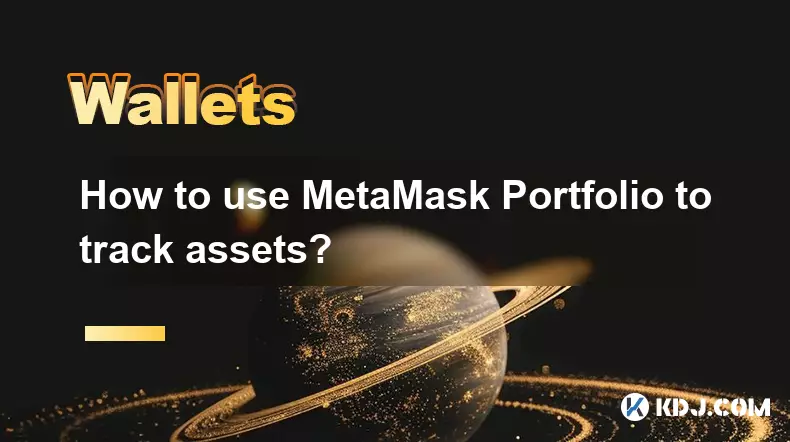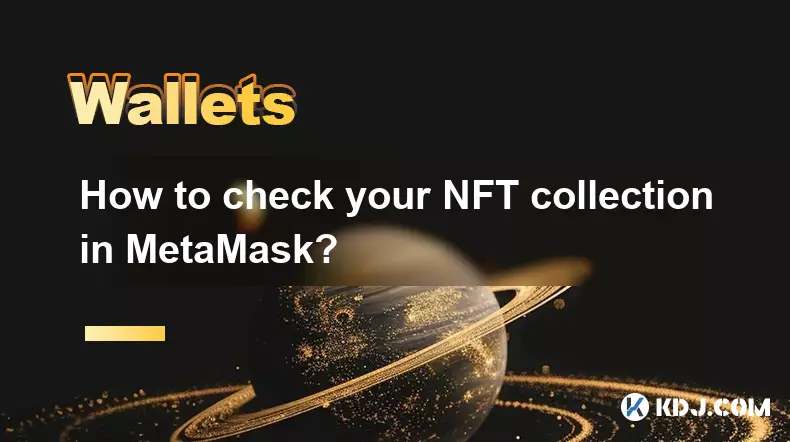-
 bitcoin
bitcoin $101752.865364 USD
-1.09% -
 ethereum
ethereum $3382.985899 USD
-1.38% -
 tether
tether $0.999658 USD
0.04% -
 xrp
xrp $2.272505 USD
-1.51% -
 bnb
bnb $989.089004 USD
0.14% -
 solana
solana $156.962612 USD
-3.08% -
 usd-coin
usd-coin $0.999776 USD
0.01% -
 tron
tron $0.290786 USD
-0.69% -
 dogecoin
dogecoin $0.174594 USD
-2.86% -
 cardano
cardano $0.560085 USD
-3.55% -
 hyperliquid
hyperliquid $40.023704 USD
-5.75% -
 chainlink
chainlink $15.324649 USD
-2.78% -
 bitcoin-cash
bitcoin-cash $493.576540 USD
-3.52% -
 zcash
zcash $571.320038 USD
-12.05% -
 stellar
stellar $0.280066 USD
-4.26%
How to manage multiple portfolios in Exodus?
Exodus allows portfolio-like management by creating multiple wallets with unique seed phrases, enabling users to separate and organize crypto assets by investment strategy.
Sep 07, 2025 at 04:00 pm

Understanding Portfolio Management in Exodus
Exodus is a digital wallet that supports a wide range of cryptocurrencies, allowing users to store, exchange, and manage their assets from a single interface. While Exodus does not offer native support for completely separate portfolios within the app, users can strategically organize their holdings to simulate multiple portfolio management. This approach enables individuals to allocate funds based on investment goals, risk tolerance, or time horizons.
Each wallet instance in Exodus is tied to a single seed phrase, meaning true portfolio separation requires external strategies. Users who want distinct portfolios must create multiple Exodus wallets, each with its own seed phrase and password. This method ensures that assets are isolated and managed independently, reducing the risk of cross-contamination between investment strategies.
- 1. Install the Exodus application on your device and complete the initial setup to create your first wallet.
- 2. During setup, securely back up the 12-word recovery phrase in a physically secure location.
- 3. After securing the seed phrase, label the wallet according to its intended purpose—such as “Long-Term Holdings” or “Trading Fund.”
- 4. Repeat the installation and setup process on the same or another trusted device to generate a second wallet with a unique seed phrase.
- 5. Assign a different investment strategy or asset mix to each wallet to maintain clear portfolio boundaries.
Strategies for Organizing Multiple Wallets
Managing several Exodus wallets effectively requires a disciplined approach to labeling, backup, and access control. Without proper organization, users risk confusion or loss of funds due to misplaced seed phrases or misallocated assets.
Using descriptive names and documentation helps maintain clarity across multiple wallets. For example, one wallet could be designated for high-risk altcoins, while another holds stablecoins and blue-chip cryptocurrencies like Bitcoin and Ethereum.
- 1. Maintain a secure, offline document listing each wallet’s purpose, creation date, and associated seed phrase (stored separately).
- 2. Use unique and strong passwords for each wallet if password protection is enabled.
- 3. Store seed phrases in fireproof safes or metal backup solutions to prevent damage.
- 4. Avoid digital storage of recovery phrases, including cloud services or screenshots.
- 5. Periodically verify access to each wallet by restoring it on a test device using the seed phrase.
Transferring and Monitoring Assets Across Wallets
Once multiple Exodus wallets are set up, moving assets between them requires initiating standard cryptocurrency transfers. Each wallet operates independently, so transactions must be manually executed through send and receive functions.
Transaction fees apply for every transfer, so users should factor in network costs when rebalancing between wallets. Monitoring performance across wallets also demands manual tracking, as Exodus does not provide consolidated reporting across separate installations.
- 1. Open the source wallet and select the cryptocurrency to transfer.
- 2. Click “Send” and enter the receiving address from the target Exodus wallet.
- 3. Confirm the network (e.g., BTC, ETH, etc.) matches the asset being sent to avoid irreversible losses.
- 4. Adjust the transaction fee if available to balance speed and cost.
- 5. Use external spreadsheet tools or portfolio trackers like CoinTracker or Delta to log balances and track performance across all wallets.
Frequently Asked Questions
Can I merge two Exodus wallets into one?Yes, you can consolidate funds by sending cryptocurrencies from one Exodus wallet to another. However, the wallets themselves remain separate entities with distinct seed phrases. Merging assets does not combine the wallets into a single unified account.
Does Exodus support portfolio labels within the app?No, Exodus does not currently offer internal labeling or segmentation features for different portfolios within a single wallet. Users must rely on external organizational methods or run multiple wallet instances.
What happens if I lose a seed phrase for one of my Exodus wallets?Losing a seed phrase means permanent loss of access to that wallet and its funds. There is no recovery mechanism within Exodus. Each seed phrase is the sole key to its respective wallet.
Can I use Exodus with hardware wallets for better security?Yes, Exodus integrates with Trezor hardware wallets, allowing users to manage funds securely. This integration supports multiple accounts and can be part of a broader strategy to manage different asset allocations with enhanced protection.
Disclaimer:info@kdj.com
The information provided is not trading advice. kdj.com does not assume any responsibility for any investments made based on the information provided in this article. Cryptocurrencies are highly volatile and it is highly recommended that you invest with caution after thorough research!
If you believe that the content used on this website infringes your copyright, please contact us immediately (info@kdj.com) and we will delete it promptly.
- Ripple (XRP) in 2026: Hold or Fold? A Look at XRP's Future and Emerging DeFi Alternatives
- 2025-11-08 18:35:01
- Zcash ZEC Coin Price Explosion: From Privacy Niche to Center Stage
- 2025-11-08 18:55:01
- Berachain Price Prediction: Navigating the Honeycomb Hype in Crypto
- 2025-11-08 18:55:01
- Arthur Hayes, Gold, and Bitcoin: A Modern Monetary Trinity?
- 2025-11-08 19:15:01
- Shiba Inu's Next Move: Navigating a Shifting Market
- 2025-11-08 19:20:01
- Pakistan's Crypto Crossroads: Balancing Opportunity with Asset-Backed Realities
- 2025-11-08 19:20:01
Related knowledge

How to use MetaMask Portfolio to track assets?
Nov 08,2025 at 05:40am
Getting Started with MetaMask Portfolio1. Download and install the MetaMask mobile app from the App Store or Google Play. Open the app and select 'Imp...

MetaMask not popping up: how to fix this issue?
Nov 10,2025 at 05:59am
Understanding the MetaMask Pop-Up Issue1. MetaMask is one of the most widely used cryptocurrency wallets, especially for interacting with decentralize...

How to send ETH from Binance to MetaMask?
Nov 10,2025 at 04:40am
Sending ETH from Binance to MetaMask: A Step-by-Step GuideTransferring Ethereum (ETH) from your Binance account to your MetaMask wallet is a common op...

How to check your NFT collection in MetaMask?
Nov 06,2025 at 08:20pm
Accessing Your NFTs in MetaMask Wallet1. Open the MetaMask browser extension or mobile app and ensure you are logged into your wallet account. Once in...

Why is the MetaMask swap feature failing?
Nov 06,2025 at 09:20pm
Understanding MetaMask Swap FailuresMetaMask, one of the most widely used cryptocurrency wallets, enables users to swap tokens directly within the int...

How to update the MetaMask extension in Chrome?
Nov 08,2025 at 07:39am
Updating the MetaMask extension in Chrome is a simple process that ensures you have access to the latest security features, performance improvements, ...

How to use MetaMask Portfolio to track assets?
Nov 08,2025 at 05:40am
Getting Started with MetaMask Portfolio1. Download and install the MetaMask mobile app from the App Store or Google Play. Open the app and select 'Imp...

MetaMask not popping up: how to fix this issue?
Nov 10,2025 at 05:59am
Understanding the MetaMask Pop-Up Issue1. MetaMask is one of the most widely used cryptocurrency wallets, especially for interacting with decentralize...

How to send ETH from Binance to MetaMask?
Nov 10,2025 at 04:40am
Sending ETH from Binance to MetaMask: A Step-by-Step GuideTransferring Ethereum (ETH) from your Binance account to your MetaMask wallet is a common op...

How to check your NFT collection in MetaMask?
Nov 06,2025 at 08:20pm
Accessing Your NFTs in MetaMask Wallet1. Open the MetaMask browser extension or mobile app and ensure you are logged into your wallet account. Once in...

Why is the MetaMask swap feature failing?
Nov 06,2025 at 09:20pm
Understanding MetaMask Swap FailuresMetaMask, one of the most widely used cryptocurrency wallets, enables users to swap tokens directly within the int...

How to update the MetaMask extension in Chrome?
Nov 08,2025 at 07:39am
Updating the MetaMask extension in Chrome is a simple process that ensures you have access to the latest security features, performance improvements, ...
See all articles





















![The Graph Price Prediction [GRT Crypto Price News Today] The Graph Price Prediction [GRT Crypto Price News Today]](/uploads/2025/11/07/cryptocurrencies-news/videos/690d4df44fe69_image_500_375.webp)




















































